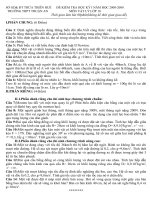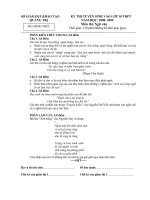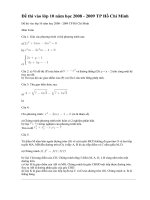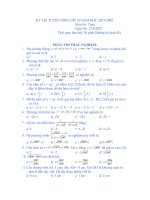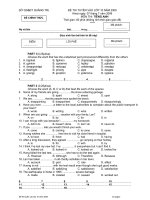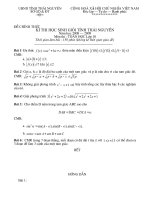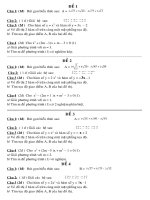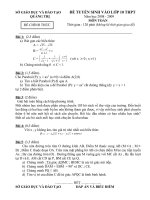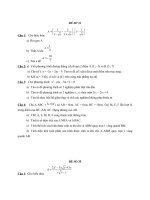Đề Thi Cụm Lớp 10 Năm 2016.Docx
Bạn đang xem bản rút gọn của tài liệu. Xem và tải ngay bản đầy đủ của tài liệu tại đây (98.02 KB, 15 trang )
HỘI CÁC TRƯỜNG CHUYÊN
VÙNG DUYÊN HẢI & ĐỒNG BẰNG BẮC BỘ
ĐỀ THI MÔN: ANH VĂN
TRƯỜNG THPT CHUYÊN
KHỐI 10
LÊ HỒNG PHONG – NAM ĐỊNH
Thời gian làm bài: 180 phút
ĐỀ THI ĐỀ XUẤT
(Đề thi gồm 14 trang)
I. LISTENING (40 points)
1. Part 1 (20 points) (IELTS PRACTICE TESTS – JAMES MILTON)
Question 1-7: Complete the following notes using A WORD or SHORT PHRASE for
each answer.
Borchester University
Example: Where to get …food…on campus
PLACE
CAPACITY
Main Refectory Hall 500
REGULAR MENU
vegetarian, fish, (1) ..……..
COST
(3) ……….. - £3
Open: (2) …………
Arts Building Café
(4) .…………
tea, coffee, hot chocolate, (5) ……………..
Open: 9 - 6
sandwiches
(6)……………..Bar
tea, coffee,
Open: 10 - 4
(7) ………….. sandwiches
£1.30
Question 8-10: Complete the sentences below. Write NO MORE THAN THREE
WORDS for each answer.
8. You can hear a concert of classical music every………………….
9. The jazz concerts start at……………………………….
10. You can smoke in…………………………………………
Page 1
2. Part 2: You are going to hear two students discussing a talk by a paleontologist
(a fossil expert). Listen and choose the best answers. (10 points) (CAMBRIDGE
IELTS)
1. Why did Milton miss the talk on fossils?
A. He attended a different lecture.
B. He had to catch up on some work.
C. He was not interested in the subject.
2. What started Mr Brand’s interest in fossils?
A. a trip to America.
B. a chance discovery.
C. a film he saw as a child.
3. What do schoolchildren say they most enjoy about the fossil hunts?
A. looking for fossils in the rocks.
B. having their photo taken with a fossil.
C. being able to take the fossils home.
4. During a fossil hunt, the main thing children learn is that
A. history is all around them.
B. it is important to be careful.
C. patience leads to rewards.
5. What do Juni and Milton agree to do?
A. persuade Mr Brand to run a fossil hunt for them.
B. use the Internet to book a place on a fossil hunt.
C. talk to some people who have been on a fossil hunt.
3. Part 3: You will hear a woman asking a tutor for more information about a
Media
Studies course at a university. Listen and decide whether the following statements
are
true or false. (10 points) (IELTS PRACTICE TESTS – JAMES MILTON)
1. Louise worked at a radio station for about 4 years.
Page 2
2. Louise wants to do a Masters because employers like post-graduate
qualifications.
3. It will take 4 years to do the Masters part-time rather than the modular route.
4. To join the course, Louis must have research experience and a completed thesis
5. Students can find the details on funding on the university website.
II. LEXICO – GRAMMAR (60 points)
Part 1: Choose the best answer to each of the following questions. (20 points)
1. It was only when he had been unemployed for six months that Neil’s situation
hit……..
A. base
B. down
C. home
D. back
2. We were all on a ………………-edge until the very end of the Hitchcock film.
A. razor
B. cliff
C. knife
D. chair
3. Always having had ……………..feet, Delia is off again, backpacking round India.
A. itchy
B. scratchy
C. sore
D. light
4. Were you on the …………… when you said you had resigned from work?
A. wagon
B. level
C. flat
D. town
5. I left the house in a hurry and my bedroom was…………….with clothes.
A. scattered
B. dispersed
C. strewn
D. sprinkled
6. Employees of the company are forbidden to………information about the secret
formula.
A. betray
B. divulge
C. portray
D. unveil
7. Young children are often …………….. to illnesses such as measles.
A. liable
B. apt
C. sensitive
D. susceptible
8. “ All the money collected will be in………….of Cancer Relief.
A. aid
B. help
C. cause
D. hope
9. …………………..do his views reflect those of the company as a whole?
A. To what extent
B. In what condition
C. Under what circumstances
D. To what end
10. “There is no further treatment we can give,” said Jekyll. “ We must let the disease
take its …………….”
Page 3
A. course
B. end
C. term
D. way
11. The President decided to release a number of political prisoners as a(n)……………..
of goodwill.
A. gesture
B. indication
C. pledge
D. symbol
12. “Relax,” said Harry. “We’re ………………….the worst.”
A. over
B. against
C. done with
D. finished off
13. He broke his arm in two places and it was a long time before the bones
would……………
A. cure
B. seal
C. knit
D. join
14. The helicopter ………………………..over the ship and lowered a doctor onto the deck.
A. flew
B. stationed
C. hovered
D. stayed
15. The cut on his face needed twelve ………………..
A. threads
B. links
C. stitches
D. joins
16. This book will be a delight to……………….readers of science fiction.
A. amateur
B. skilled
C. seasoned
D. loving
17. The two sides are entrenched and any meeting between them is unlikely to
………………a result.
A. submit
B. force
C. yield
D. concede
18. After years of working together, the partners found themselves……..linked.
A. permanently
B. indelibly
C. perpetually
D. inextricably
19. Christopher is prepared to ………………..his professional reputation on the idea that
this stone circle originally had an astronomical purpose.
A. risk
B. bet
C. gamble
D. stake
20. He works hard, but …………………. of his health
A. at the expense
B. at the limit
C. at a cost
D. at a loss
Part 2: The passage below contains 10 mistakes. Identify the errors and write the
corrections. (10 points)
Line
1
Human and primates, the family of apes, gorillas, and
chimpanzees, among others, divide many common traits. While
Page 4
2
primates are deemed the most intelligent of animals, most
3
researchers believed they lack the capacity to produce language.
4
However, a research project in the 1970s at University of
5
Georgia showed promise that chimpanzees have the abilit to
6
learn a certain language, just as human children do. The project
7
used several chimpanzees as test subjects in which Lana , a
8
female chimp was the study focus .Though the primates lack the
9
vocal construct ions to make human speech patterns, the
10
researchers created a language called Yerkish, using lexigram
11
made up of symbols that represent sounds and words. 125
12
symbols were placed on a keyboard, which Lana was taught how
13
to use the board to communicate with the researchers. She
14
successfully expressed her thoughts by pressing different keys
15
in succession. In some cases, she used up to seven at times.
16
Part 3: Complete the following sentences with the correct prepositions or particles.
(10 points)
1. You will have to answer ………… your behaviour one day.
2. His parents really laid …………….. him for wasting so much money.
3. He laughed ………………… suggestions that he was going to resign.
4. We had to resign ourselves ………… making a loss on the sale.
5. His teachers are full of praise ………….. the progress he's making
6. The damage to the building is put ………………. over $1 million.
7. That's a philosophy I could live ………………….
8. Steve threw……………………his chances of passing by spending too much time on the
first question.
9. We were extremely gratified …………….. the number of people who supported us.
10. She has a deep aversion ………….. getting up in the morning.
Page 5
Part 4: Write the correct form of each bracketed word in the following passage.
(20 points)
THE WORLD TODAY
One way to stay abreast of and have intelligent opinion on global issues is by reading
The World Today. By doing this you will receive a regular and ……………… (1. BIAS)
briefing on the people and events that shape our world. Each week, this publication
………………. (2. TANGLE) the important issues through concise, informative and
challenging articles. The most complex subjects are presented with…………………………
(3. CLEAR), so you will acquire an ………………….. (4. DEEP) and focused knowledge of
countries, industries and topics of worldwide concern. The World Today is ………………..
(5. SURPASS) for the quality of its reporting. Regular feature articles examine a range
of…………………… (6. CONTEND) issues, from international trade wars to the
exploitation of …………………….. (7. REFUGE).
In short, The World Today makes the world a little more comprehensible. A
……………………… (8. SUBSCRIBE) to The World Today is a sound business decision.
Take advantage of our exclusive introductory offer: you can save 55% off the usual
price if you return your order within the next 21 days. The price includes free
…………….… (9. DELIVER) and immediate access to our online library. Now is
……………………… (10. QUESTION) the right time to join many of the world’s business
and national leaders who read The World Today.
III. READING COMPREHENSION (60 points)
Part 1: Choose the words that best complete the sentences in the text. (15 points)
If a picture is (1)…………….. a thousand words, the seventy-three scenes of the
Bayeux Tapestry speak volumes. The tapestry narrates, in pictorial (2)………………,
William, Duke of Normandy's invasion and conquest of England in AD 1066, when he
(3) …………….. the Saxon forces of King Harold at Hastings.
Historians believe that the work was (4)…………….. in England, probably around AD
1092, and that it was commissioned by Odo, Bishop of Bayeux, William's half brother,
who (5)……………… his fame by figuring (6)……………….. in the tapestry's later (7)
Page 6
…………….. . Legends connecting it with William's wife Matilda have been (8)
……………………..
The Bayeux tapestry is not, (9) ……………. speaking, a tapestry, in which design are
woven into the fabric, but rather a crewel form of embroidery, the pictures being
made by stitching wollen threads into a background of plain linen. The threads, in (10)
…………… of red, yellow, blue and green, must (11)……………… have been jewel bright,
but have (12)……………….. light brown with age. Moreover, one (13)………….. of the now
20 inch (50 cm) broad and 231 feet (70 cm) long cloth is missing.
You can find the Bayeux Tapestry in the William the Conqueror Centre, Bayeux,
Normandy, France. An enduring (14)…………….. of the times, it is as valuable a (15)
………… of evidence for the Norman Conquest as photographs or film are today.
1. A. valued
B. worth
C. merited
D. deserving
2. A. fashion
B. type
C. design
D. form
3. A. defeated
B. won
C. defended
D. invaded
4. A. originated
B. invented
C. created
D. manufactured
5. A. insured
B. made sure
C. ensured
D. assured
6. A. prominently
B. strongly
C. powerfully
D. sufficiently
7. A. views
B. scenes
C. frames
D. pictures
8. A. disowned
B. dispersed
9. A. normally
B. strictly
C. truly
D. sincerely
10. A. colors
B. shadows
C. shades
D. earlier
11. A. once
B. then
C. before
D. deserving
12. A. changed
B. turned
C. transformed
D. developed
13. A. end
B. side
C. tip
D. part
14. A. witness
B. confirmation
C. testimony
15. A. segment
B. part
C. piece
C. disgraced
D. discounted
D. proof
D. portion
Part 2: Read the following text. Fill each blank with ONE suitable word. Write your
answers in the numbered blanks provided below the passage. (15 points)
LIFE IN THE FAST LANE
Page 7
In our modern, competitive world, employers are beginning to expect almost
complete …………………. (1) from their employees. But what is it that is leading a
growing army of workers to tolerate such heavy demands all for the ………………….. (2)
of earning a little money? Peer pressure is certainly a part of it. Incessant media
pressure has a lot to ……………(3) for too. We are bombarded by images of the latest
products …………….. (4) to those who are in the right earning group and the fact that
the majority of people use plastic to purchase goods these days is …………….. (5) of the
“spend now, pay later” culture that is blighting modern society and leading so many
into debt.
The prevailing trend for young people to spend hours surfing the internet and
the growing popularity of eBay has …………… (6) it all too easy for people to purchase
expensive goods without really coming to ……………… (7) with how much money they
are spending. Perhaps, most at fault, however are the credit card companies and banks
that permit and often blatantly encourage people to spend beyond their means. Once
people are ………………….. (8) in this kind of financial trap, it is incredibly difficult for
them to extract themselves from the burden of interest that must be paid on expensive
loans and overdrafts.
So how can we learn to evaluate our life in a more constructive manner? There is
a need to regain some of the basic priorities and values of the past. There needs to be a
……………………… (9) in emphasis from materialism to building and maintaining
personal relationship, both within a ………………… (10) circle of family and friends and
with colleagues and associates. Welfare needs to become the number one priority in a
world that is becoming smaller through technology. The global village needs to adopt a
village mentality of caring by going back to the basics.
Part 3: Read the following passage and choose the best answer to each question.
(15 points)
Printmaking is the generic term for a number of processes, of which woodcut and
engraving are two prime examples. Prints are made by pressing a sheet of paper (or
other material) against an image-bearing surface to which ink has been applied. When
the paper is removed, the image adheres to it, but in reverse.
Page 8
The woodcut had been used in China from the fifth century A.D. for applying
patterns to textiles. The process was not introduced into Europe until the fourteenth
century, first for textile decoration and then for printing on paper. Woodcuts are
created by a relief process; first, the artist takes a block of wood, which has been
sawed parallel to the grain, covers it with a white ground, and then draws the image
in ink. The background is carved away, leaving the design area slightly raised. The
woodblock is inked, and the ink adheres to the raised image. It is then transferred to
damp paper either by hand or with a printing press.
Engraving, which grew out of the goldsmith's art, originated in Germany and
northern Italy in the middle of the fifteenth century. It is an intaglio process (from
Italian intagliare, "to carve"). The image is incised into a highly polished metal plate,
usually copper, with a cutting instrument, or burin. The artist inks the plate and wipes
it clean so that some ink remains in the incised grooves. An impression is made on
damp paper in a printing press, with sufficient pressure being applied so that the
paper picks up the ink.
Both woodcut and engraving have distinctive characteristics. Engraving lends
itself to subtle modeling and shading through the use of fine lines. Hatching and crosshatching determine the degree of light and shade in a print. Woodcuts tend to be more
linear, with sharper contrasts between light and dark. Printmaking is well suited to the
production of multiple images. A set of multiples is called an edition. Both methods can
yield several hundred good-quality prints before the original block or plate begins to
show signs of wear. Mass production of prints in the sixteenth century made images
available, at a lower cost, to a much broader public than before.
1. What does the passage mainly discuss?
A. The origins of textile decoration
B. The characteristics of good-quality prints
C. Two types of printmaking
D. Types of paper used in printmaking
2. The word "prime" in line 2 is closest in meaning to
A. principal
B. complex
C. general
3. The author's purposes in paragraph 2 is to describe
A. the woodcuts found in China in the fifth century
Page 9
D. recent
B. the use of woodcuts in the textile industry
C. the process involved in creating a woodcut
D. the introduction of woodcuts to Europe
4. The word "incised" in line 14 is closest in meaning to
A. burned
B. cut
C. framed
D. baked
5. Which of the following terms is defined in the passage?
A. "patterns" (line 5)
B. "grain" (line 8)
C. "burin" (line 15)
D. "grooves" (line 16)
6. According to the passage, all of the following are true about engraving EXCEPT that
it
A. developed from the art of the goldsmiths
B. requires that the paper be cut with a burin
C. originated in the fifteenth century
D. involves carving into a metal plate
7. The word "yield" in line 22 is closest in meaning to
A. imitate
B. produce
C. revise
D. contrast
8. According to the passage, what do woodcut and engraving have in common?
A. Their designs are slightly raised.
B. They achieve contrast through hatching and cross-hatching.
C. They were first used in Europe.
D. They allow multiple copies to be produced from one original.
9. According to the author, what made it possible for members of the general public to
own prints in the sixteenth century?
A. Prints could be made at low cost.
B. The quality of paper and ink had improved.
C. Many people became involved in the printmaking industry.
D. Decreased demand for prints kept prices affordable.
10. According to the passage, all of the following are true about prints EXCEPT that
they
A. can be reproduced on materials other than paper
Page 10
B. are created from a reversed image
C. show variations between light and dark shades
D. require a printing press
Part 4: Read the following passage and do the tasks that follow.(15 points)
The History of Writing
1.
The earliest stage of writing is called pre-writing or proto-literacy, and depends on
direct representation of objects, rather than representing them with letters or other
symbols. Evidence for this stage, in the form of rock and cave paintings, dates back to
about 15,000 years ago, although the exact dates are debatable. This kind of protoliterate cave painting has been found in Europe, with the best know examples in
South- Western France, but also in Africa and on parts of the American continent.
These petrographs (pictures on rock) show typical scenes of the period, and include
representations of people, animals and activities. Most are astonishingly beautiful,
with a vibrancy and immediacy that we still recognise today. They are painted with
pigments made from natural materials including crushed stones and minerals, animal
products such as blood, ashes, plant materials of all kinds, and they produce a wide
range of colours and hues.
2.
Why did ancient people put such effort into making them? Various theories have been
put forward, but the most compelling include the idea that the pictures were records
of heroic deeds or important events, that they were part of magical ceremonies, or that
they were a form of primitive calendar, recording the changes in the seasons as to why
man started to write.
3.
A related theory suggests that the need for writing arose thereafter from the
transactions and bartering that went on. In parts of what is now Iraq and Iran, small
pieces of fired earth-pottery- have been found which appear to have been used as
tokens to a casino, or money, today. Eventually, when the tokens themselves became
Page 11
too numerous to handle easily, representations of the tokens were inscribed on clay
tablets.
4.
An early form of writing is the use of pictograms, which are pictures used to
communicate. Pictograms have been found from almost every part of the world and
every era of development, and are still in use in primitive communities nowadays.
They represent objects, ideas or concepts more or less directly. They tend to be simple
in the sense that they are not a complex or full picture, although they are impressively
difficult to interpret to an outsider unfamiliar with their iconography, which tends to
be localised and to differ widely form society to society. They were never intended to
be a detailed testimony which could be interpreted by outsiders, but to serve instead
as aide- memoires to the author, rather as we might keep a diary in a personal
shorthand. However, some modern pictograms are more or less universally
recognised, such as the signs which indicate men’s and women’s toilets, or road signs,
which tend to be very similar throughout the world.
5.
The first pictograms that we know of are Sumerian in origin, and date to about 8000
BC. They show how images used to represent concrete objects could be expanded to
include abstractions by adding symbols together, or using associated symbols. One
Sumerian pictogram, for example, indicates ‘death’ by combining the symbols for ‘man’
and ‘winter’; another shows ‘power’ with the symbol for a man with the hands
enlarged.
6.
By about 5,000 years ago, Sumerian pictograms had spread to other areas, and the
Sumerians had made a major advance towards modern writing with the development
of the rebus principle, which meant that symbols could be used to indicate sounds.
This was done by using a particular symbol not only for the thing it originally
represented, but also for any thing which was pronounced in a similar way. So the
pictogram for na (meaning ‘animal’) could also be used to mean ‘old’ (which was also
Page 12
pronounced na). the specific meaning of the pictogram (whether na meant ‘old’ or
‘animal’) could only be decided through its context.
7.
It is a short step from this to the development of syllabic writing using pictograms, and
this next development took about another half a century. Now the Sumerians would
add pictograms to each other, so that each, representing an individual sound- or
syllable- formed part of a larger word. Thus pictograms representing the syllables he,
na and mi (‘mother’, ‘old’, ‘my’) could be put together to form henami or
‘grandmother’.
Question 1-5: Choose the most suitable headings for paragraphs 1-7 from the list
of headings below. Write the appropriate letters A-H in boxes 1-7 on your answer
sheet. There are more headings than paragraphs, so you will not use them all.
Paragraph 2 and 3 have been done for you.
Paragraph Headings
A Magic and Heroes
D
B Doing Business
Symbols
C
Sounds
and G A Personal Record
Early E Images on Stone
Developments
H
From Visual to
Sound
F Stories and Seasons
Paragraph 2 – F
Paragraph 3 – B
Question 6-10: Complete the following notes on Reading Passage 3 using ONE or
TWO WORDS from the Reading Passage for each answer. Write your answers in
boxes 8-12 on your answer sheet.
Notes on the Development of Writing
First stage of writing- pre- writing or proto- literacy- very old- 15,000 years. Evidence:
cave and rock paintings. Famous example- …………………….(6). Reasons for
development of writing: primitive ceremonies, recording events, seasons, used on
pottery to represent………………….(7). Next stage: simple pictograms- pictures used to
represent articles and…………………….(8). Very simple drawings (but very difficult to
understand). Then- 8000 BC – combined………………(9) to create new concepts (eg.
Page 13
Man + winter = death). After this- started using same pictogram for different words
with same………………….(10). Very important step.
IV. WRITING (40 points)
Part 1: Complete the second sentence so that it has a similar meaning to the first
sentence, using the word given. Do not change the word given. You must use
between TWO and SIX words, including the word given. (7.5 points)
1. Simon couldn't remember ever having met the woman. RECOLLECTION
Simon …………………………………………………… ever having met the woman.
2. He didn't seem to consider anything to be as important as winning the medal.
MATTER
Nothing ………………………………………………………. winning the medal.
3. The diplomat has been arrested because it is believed he had been spying for his
government. SUSPICION
The diplomat has been arrested ……………………………….. for his government.
4. Could you have a quick look at my essay before I give it in? CAST
Could you …………………………………………………. before I give it in?
5. Sally Smith became known throughout the country as a result of her popular TV
series. HOUSEHOLD
Sally Smith became …………………………………….as a result of her popular TV series.
Part 2: Finish each of the following sentences in such a way that it means exactly
the sentence before it. (7.5 points)
1. You don't have to come and see the new house if you don't wish.
=> You are under……………………………………
2. He threatened the officers with violence.
=> He made……………………………………
3. The headmaster has a very good opinion of the physics teacher.
=> The headmaster holds………………………………………………
4. He himself admits to a fear of spiders.
=> On his……………………………………………………………….
5. Suzanne is far superior to me in terms of technical knowledge.
Page 14
=> When it……………………………………………………………………
Part 3: Write a paragraph of about 150 words on the following topic: (25 points)
Tourism is becoming an important industry in the world.
What benefits and challenges does it present?
Page 15
